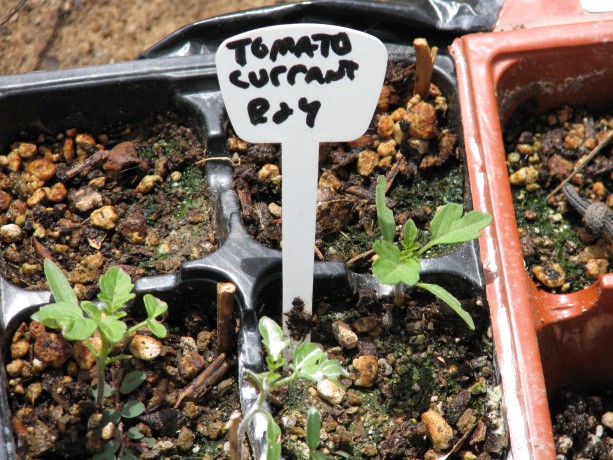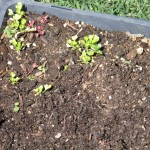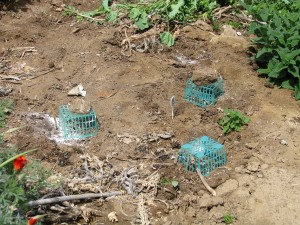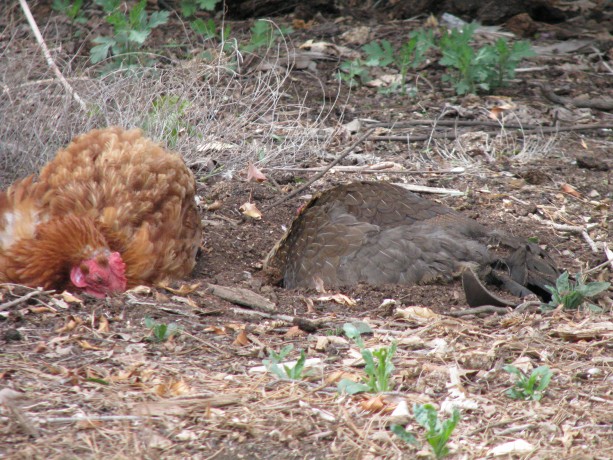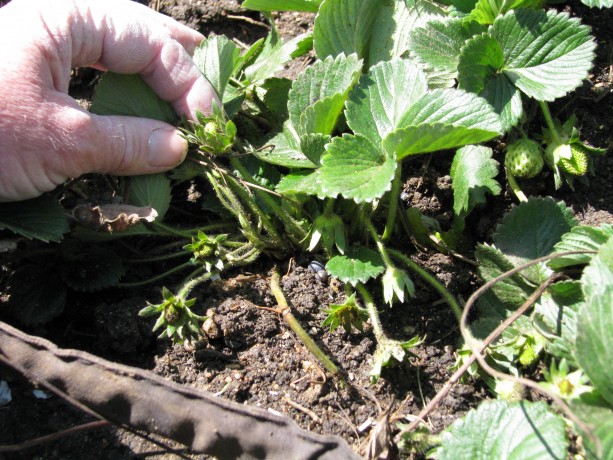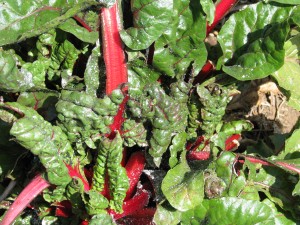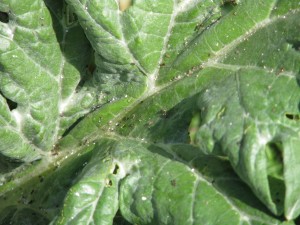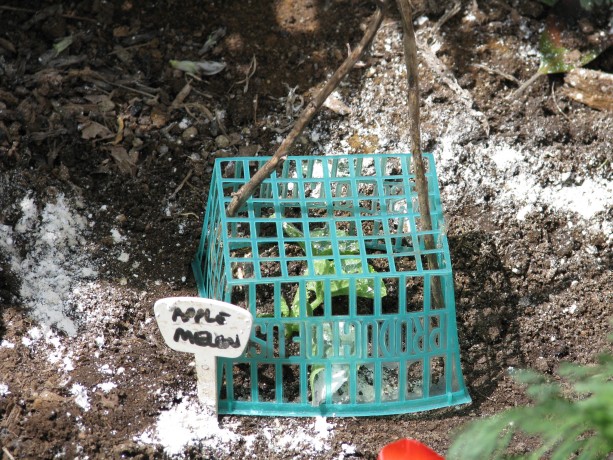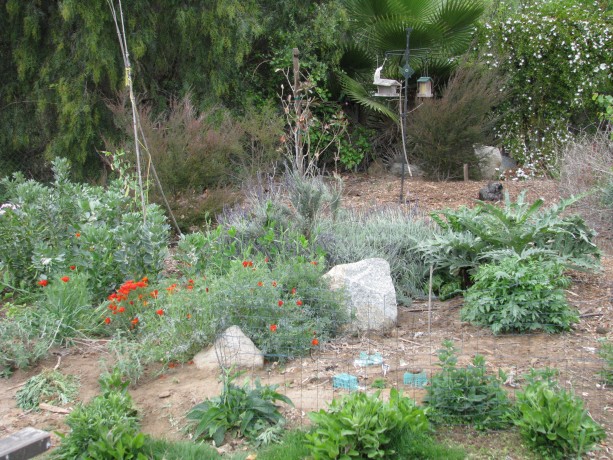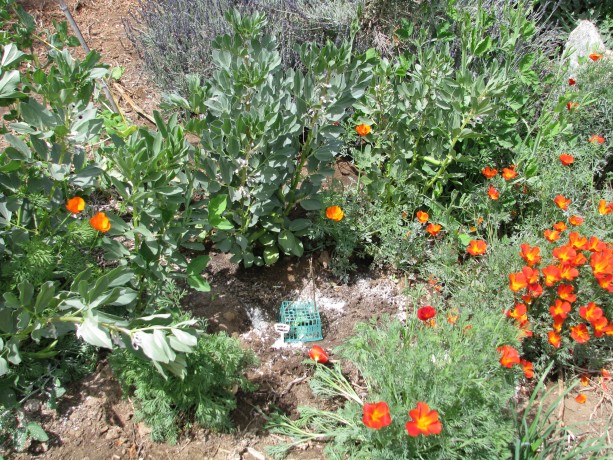Chickens
-
Release of the Pullets, and No More House Chicken
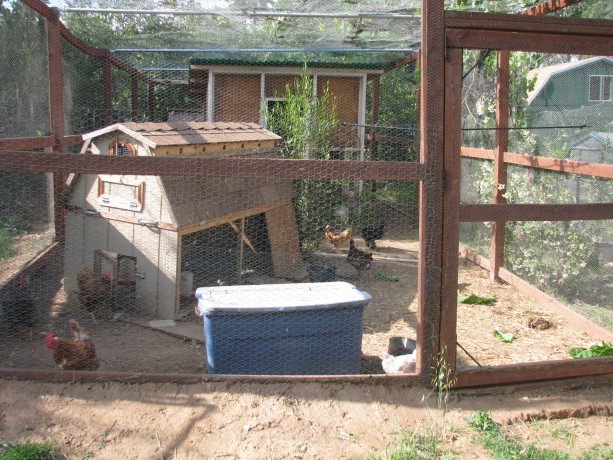
The Fowl Fortress and its many inhabitants. It was time. The little chicks were half-grown and beginning to eat scratch and pelleted chicken food along with their chick starter. They had finally figured out how to go upstairs at nighttime although it took several tries where I had to pick them out of their chick pile and shove them through the upstairs egg window. A couple of times when I’d let the big girls out into the garden, I had let the little girls out into the Fowl Fortress. They had run around stretching their wings and barreling into one another. So it was time for them to join the big girls as one large flock.
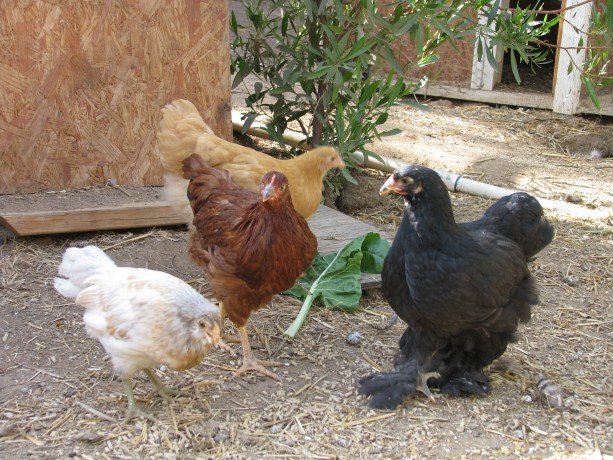
Four of the seven little girls. L-R: Belle, Charlotte, Esther (or Myrtle. They look and act the same), and Mulan (please don’t be a rooster!). And then there was Viola, the house chicken. She’d been a house chicken for over half a year, enjoying her special front yard paradise, coming when called, stealing some dog and cat food, caging herself at night, and crooning away whenever I sneezed or made noise while she slept. I really loved to have my house chicken. However she was alone a lot. She protested her aloneness by shrieking horribly for long periods of time. She could shriek with both exhaled and inhaled breath so that the noise didn’t stop. Even when at the end of my rope I yelled at her to shut up, she shrieked. She was becoming a spoiled and lonesome chicken. Her leg, the reason for her separation from the flock, was doing well again. I thought that if there was ever a good time to reintroduce her it would be at the same time that I let loose the little girls. There would be less hostility against Viola when the hens reinforced their pecking order. It was a very hard decision to make, but I thought it was for the best. I left the cage up in the house, though, just in case.
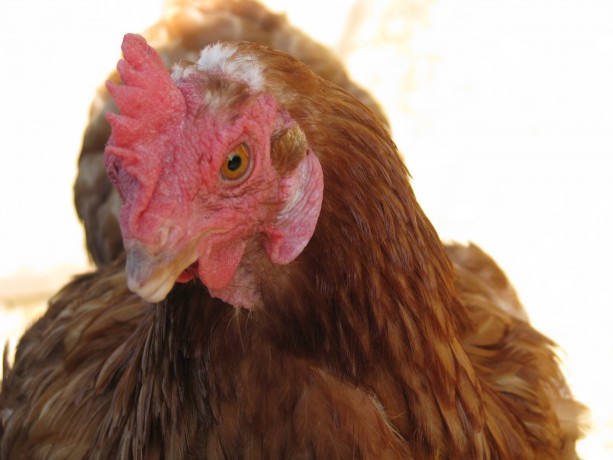
Madge: not just a rescue anymore! Uber hen! Last week I gave Viola a surprise and brought her down to the coop when I let the hens out of their chicken tractor. Viola wasn’t happy about it. Immediately Madge, the one-eyed Rhode Island Red who had been caged with Viola at the feed store when both had been seriously pecked, who had been her only friend for a year with my other girls, decided to punish Viola for her absence and make sure she knew she was at the bottom of the pecking order. She didn’t just give Viola – who is smaller – a peck, she tried to remove feathers. She jumped her and chased her. I had to get between the two of them. Pushing the vicious Blind Pirate Madge away just made her more intense, so I tried picking her up and giving her attention.
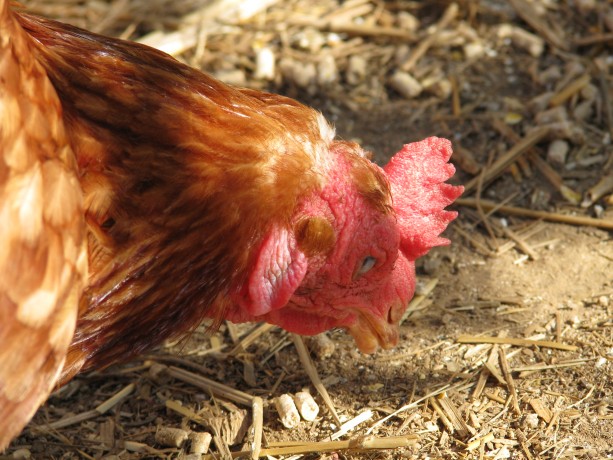
Paritally blind Madge… who’d have thought that she’d give the others the fish-eye? That worked better. Still, Viola had to hide. With Viola between my legs for protection I released the little girls.
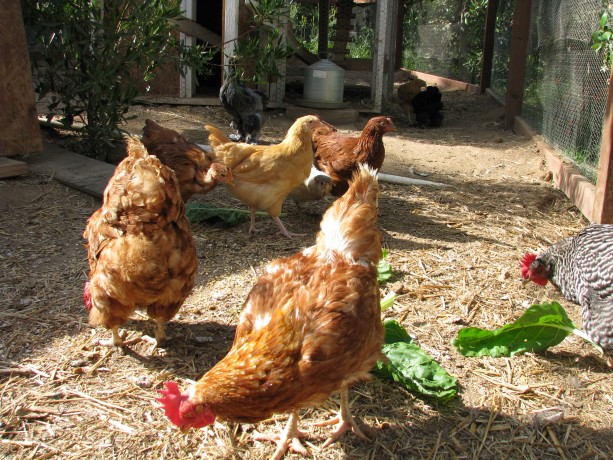
Viola staying close. L-R: Madge’s butt, Malaika, Esther (or Myrtle), behind is Bodacea, crouching is Belle, Charlotte, in the back is Myrtle (or Esther), Mulan, and on the right is Lark. Not pictured: Chickpea and Miss Amelia, the flock leader. The big hens… pretty much ignored them. The little girls were so happy to be free. I kept their food inside their coop and propped the door so that only the smaller birds could get in there, but the big girls managed to shoulder themselves in anyway.
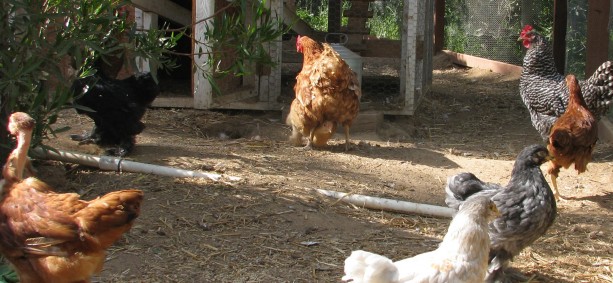
Madge shows her ranking to Myrtle as others look on in alarm. Lark, the Barred Rock who has been barren since she survived egg binding and who has been enjoying her work-free status has developed some kind of uncomfortable swelling. At first I thought she was just fat, but her tummy swelled like a balloon over several weeks. She lost her feathers on her red rump.
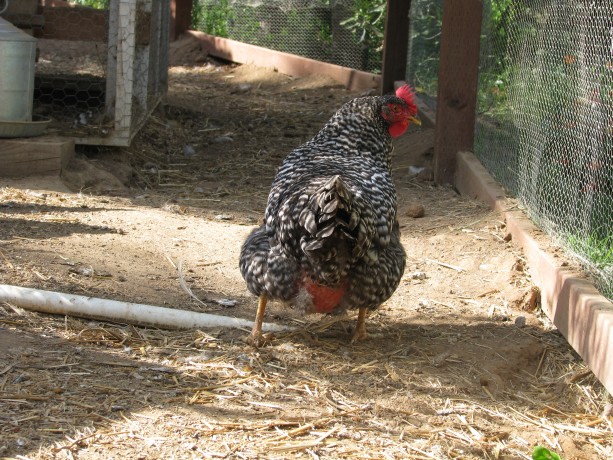
Lark’s uncomfortable ailment. It became awkward for her to walk so I gave her a couple of Epsom salt baths in the kitchen sink, and she became a house guest for a couple of days. She wasn’t as pleasant as Viola, but enjoyed the new experience. I returned her to the coop, and just today the swelling seems much less, thank goodness. The whole illness has not, however, affected her appetite.
Belle, the crossbill Americauna, had such difficulty eating that she is smaller than the rest and seemed to always be famished.
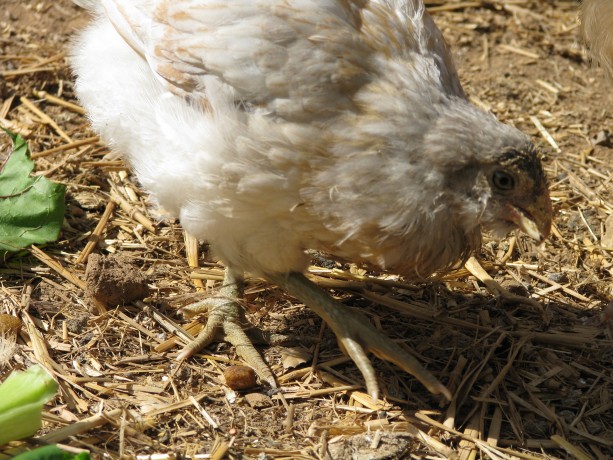
Belle, the Americauna who has the cross-bill trait. Small but sassy, and usually covered with mash. I finally found a small, deep tupperware container that I could wedge between a piece of wood and the side of her coop where it wouldn’t tip over easily, and filled it with chick starter and water mash. Belle was eating heartily for the first time since her bill began to cross and for once she had time to spend goofing around with a full tummy. And a messy face and breast. Since I’d tried trimming her beak, and since I make the magic mash for her now, she has become not only an energetic chicken but a devotee of me. While the other ingrates run away as if I were an axe murderer rather than the vegetarian that I am, Belle flies onto me at any chance. With Viola between my ankles and Belle running up my back I feel very much a part of the flock.

Ah haz a friend! -
Why Finches Turn Red, and Other Interesting Animal Dating Facts
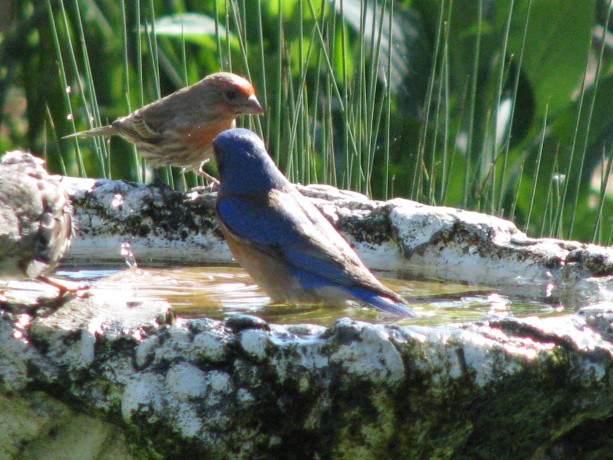
A male house finch and a male western bluebird just as mating season was kicking in. Spring is half-way through and many animals have already had their first batch of young; some are working on their second. Perhaps you noticed when some of the house finches turned a bright shade of red? In fact, many male animals look much differently than the females, becoming more brightly colored, larger, darker, or grow larger horns or antlers. This phenomena is called sexual dimorphism. This is a complicated topic when you begin to analyze all the different forms and shapes boys and girls of the animal kingdom take in order to keep their gene pool going. However I’m going to simplify it because it is pretty darn interesting.
Consider an animal; lets take a house finch. Their lives are spent finding food, finding a mate, finding lots more food for themselves and their young, and surviving predation, accidents and weather. There isn’t much time for playing around. The dawn chorus is the birds calling out that they survived another 24 hours and where is everyone else?
Consider animal calories as money. Finding food and surviving costs a lot of money/calories. For a male house finch to impress a female, they want to make sure they convey the message that they are better at finding food and more macho than the other males. This trait is essentially true for all polygamous (don’t mate for life) animals. (Let that be a lesson learned, girls!) In flocks or packs or herds that are open and often on the move, guys show their wealth through coloration, size and ornamentation. It takes more calories for the finch to turn colors, just like it takes lots of calories for peacocks to be larger and gaudier than females, or cape buffalo to be darker, or ungulates to grow really large horns. But why a brighter shade of red? The bright colors and larger size (in part) show that these males aren’t afraid of attracting the attention of predators because they are strong and macho enough to survive an attack. The darker the color, the more calories, the more fit and healthy, and thus the better food-gatherer and protector for the brood. The guys are saying, “Bring it on!”
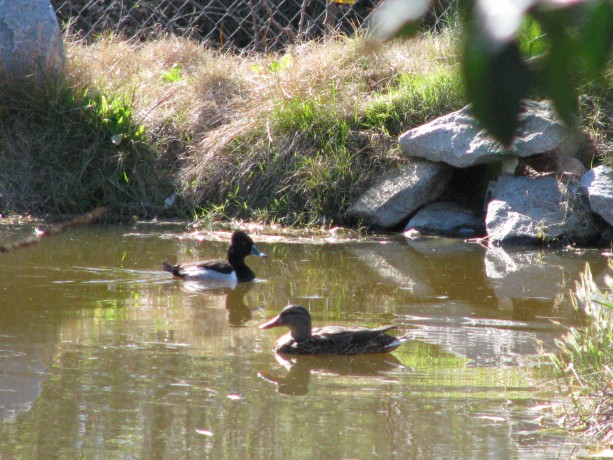
Mallard drakes are very colorful compared to the ducks. Females of these sexual dimorphic species are given a hard rap by being called dull-colored. What they are, of course, are smartly colored. They are camouflage to fit in with the area in which they will be nesting. They are thinking ahead. They don’t go in for dramatic courtship dances because they don’t have to: the guys are desperate for a healthy female to be attracted to them so that they can pass on their genes. It is a buyer’s market. Females also need to store calories because creating eggs or gestating and giving birth then feeding/producing milk and raising kids to maturity is very expensive. Isn’t it, though?
In closed herds or with animals who are monogamous (crows, for instance), the males don’t need to spend money on dates, so dressing up is just considered a waste of money/calories. (Does that sound familiar?).
As I mentioned, there are many variations on the whole sex thing, such as species where the females are larger than the males. Many spiders have this trait and it is supposed that in species who are solitary the females need to be large to be seen by the males, or to have the strength to carry young with them and feed them, and all the males need to spend calories on is, well, you know. Slam, bam, good-bye Ma’am, and all that. Until, of course, he is eaten by the female Black Widow spider. Or is murdered by the female worker bees. So it goes.
When you look out the window and see a brightly colored finch, or a large dark western fence lizard doing push-ups on a warm rock, or see deer with tremendous antlers (deer’s antler are shed every year, by the way. Antelopes have horns which are a one-time shot), you can appreciate how expensive it is for that male to put on such a show to attract a mate.
That pretty much is why we overspend on dates, too.
-
Chick’s New Home
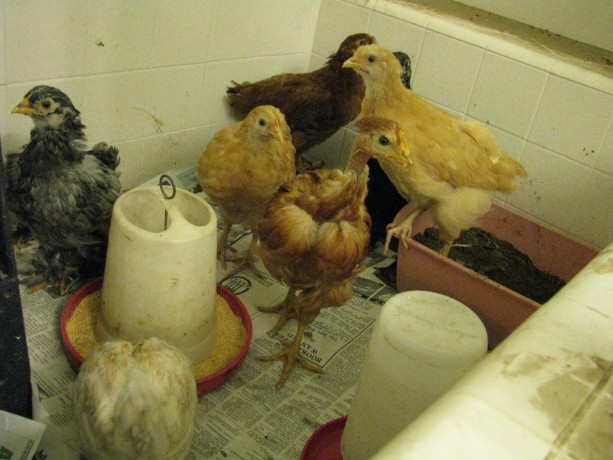
“We’re going where?” I know, I know, another chicken post. This should be the last one for awhile and I’ll get back to plants and chocolate desserts. Today I moved the 6-week-old chicks from out of the bathtub to their new quarters. They are living in a coop within the Fowl Fortress.
The coop had been occupied by Saki, a coturnix quail that ended up being male and thus having to be separate from the other two who were female. Males are extremely aggressive and usually have a harem of at least six. I don’t eat fertile eggs, nor want to hatch more quail so he was separate. He also managed to injure his wing a month ago, then a week ago escape the Fowl Fortress and unfortunately get himself killed. I miss his warbling, frantic call for his ladies. The coop had also apparently been occupied by mice and rats, as I found out when I cleaned out the top nesting portion. The rodents would only use it during the night and disappear like fairies by day, leaving lots of un-fairy-like poo all over the place. I cleaned it out on top while the big girls helped kick out all the old nesting material from the inside.

Getting a little help from my friends (Madge) cleaning out the coop. The girls (and I certainly hope they are!) were so much larger than the last time I carried them outside to the porch that I could only fit three into the banker’s box and had to put another one upside down on top to keep them there for transportation down the hill. I thought I’d put them into the top portion so they’d get familiar with it, then make their way down the ramp to the bottom.
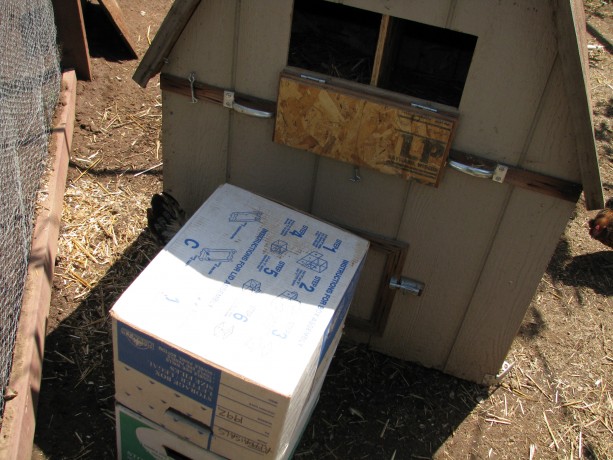
Two banker’s boxes with three huge chicks waiting to be shoved through that egg-collecting door. For over an hour all I heard was rustling, tiny little rushed footsteps and an occasional mini-squawk. I tried to entice them down, but for a long time there were no takers. Finally two came down, and one went up again, then another came down and went up again. About an hour later I looked in and they were all down enjoying the afternoon sun and wondering where the plumbing was (they lived in a bathtub… get it??? 🙂 ).
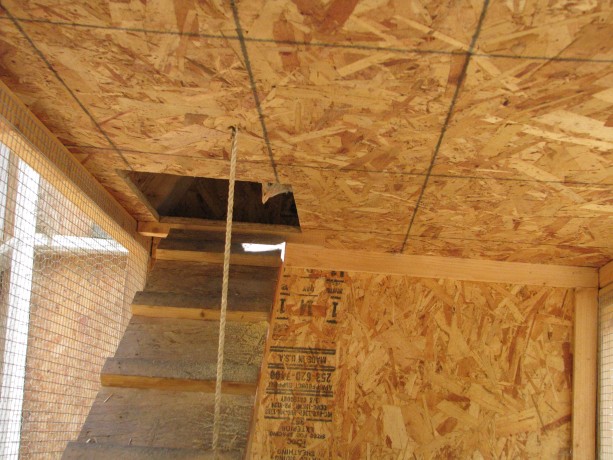
Little peepers peeping. That’s Esther, and she didn’t come down till last. However after sundown when all the big girls went into their coop, the little girls crowded around in the corner looking bewildered. I had to crawl in there, catch them and shove them back up the escape hole into the roosting area.
Kids. Sigh.
Now I need get the offer of cleaning services and clean the bathroom and the entire mostly empty bedroom which is coated with a thin film of chick dust.
But not tonight.
-
Viola the House Chicken
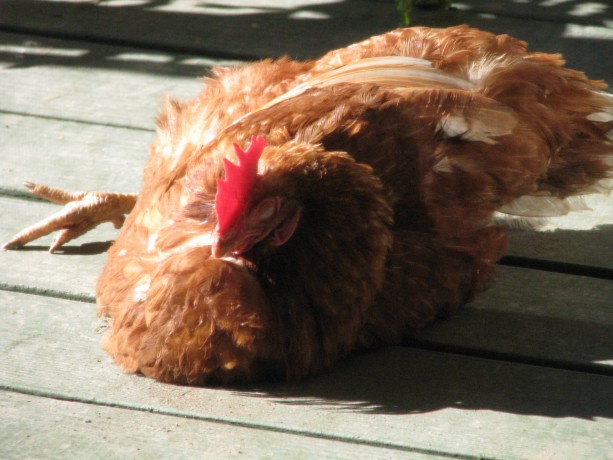
Viola snoozing in the sun. When I tell people that I have a house chicken they look at me funny. Then I launch into the explanation and sometimes afterwards they say, “I want a house chicken!” Or sometimes they just smile gently and pretend they recognize someone else with whom they’d like to speak.
Right now I not only have a house chicken, but I have a bathtub full of chickens. These are the chicks at the six-week stage, and are just about ready to put out in the Fowl Fortress. They are exercising their wings, especially Esther one of the buff orpingtons, which comes to kamikazi-ish flights into the other chicks and scattering them like bowling pins. I can be excused bathtub chickens because, after all, they are temporary. And so, I thought, was my house chicken.

Chicks at six weeks. The only one not looking at the camera is Belle, who has a crossbill and who is eating. The way Viola became a house chicken though will make much sense to you and warm the cockles of your heart.
Viola and Madge were two one-year-old Rhode Island Reds who were raised en masse at a feed store. Although the hens had had their beaks trimmed (poor dears) these two had been severely pecked. Madge is blind in one eye and Viola had a gimpy leg (and, I have come to believe, some psychological damage from the bullying). These two hens have been the sweetest girls, unlike the other hens who were coddled from day #2 and act like complete spoiled brats.
One day last Fall I went to put the chickens away and noticed that Viola was holding one leg up high and not able to put any pressure onto it. Uh-oh, I thought. I felt it all over but couldn’t tell if anything was broken. I set up a cage by the kitchen table with a heat lamp and heating pad, and hoped for the best. I spoke with the vet and researched online and everyone (all poultry-eaters, I’m sure!) said that she’d have to be put down. The leg was probably broken. She was probably in pain and showing a brave face… or beak. Well, I considered having her put down, but she didn’t appear to me to be in tremendous pain. She acted as if she’d pulled a muscle. She ate well, and after a night on the heating pad laid a very nice egg. So I kept her in. After a few days she began to use the leg a little. She certainly ate well. I took her outside into the front fenced area, formerly home to Homer the Desert Tortoise who had escaped the year before. This area has a small pond and all the bird feeders where we watch and count birds for Cornell’s Project Feederwatch. Pretty much a chicken heaven, except for the loneliness. Having been hen-pecked, she didn’t seem to mind so much.
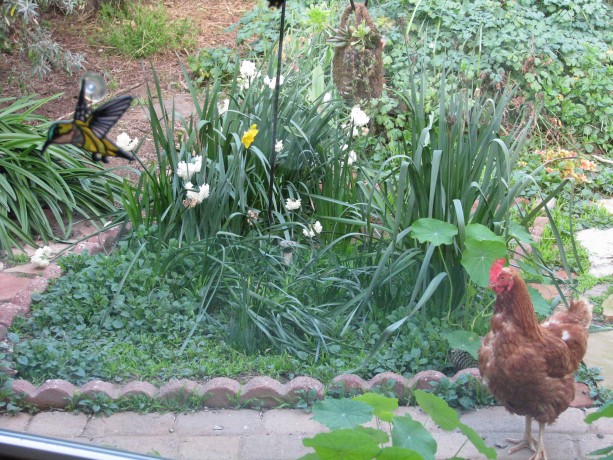
She sees us watching her as she roams Chicken Heaven. Viola improved and we developed a routine. In the morning I’d let her out and sprinkle some food for her outside. She’d wander and sun herself and roll in the dirt and eat bird seed, and lay an egg in Homer’s old house.
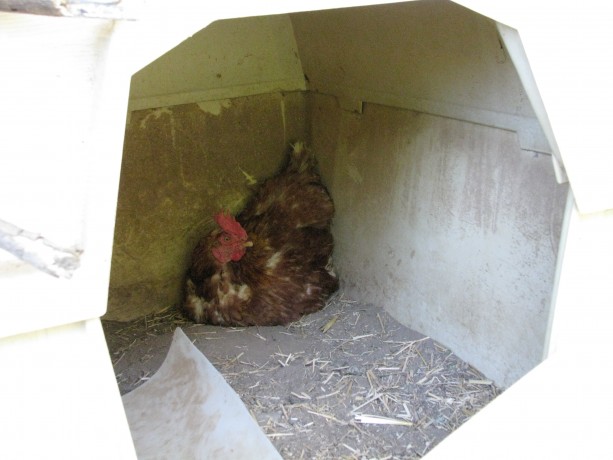
“This doghouse smells like a tortoise.” At dusk she either would tap incessantly at the sliding door to come in, or I’d go out and call, “Vi – o- laaaa,” and she’d run around the corner of the house, up the stairs and inside, making a brief stop to check out Sophie-the-dog’s dinner, then she very nicely cage herself. I’d cover her with a blanket so she could sleep while the light was on. The cats ignored her and Sophie “peace and love in her old age” -the-dog was actually a little intimidated by her. Perhaps she thought Viola was the ghost of chickens past.
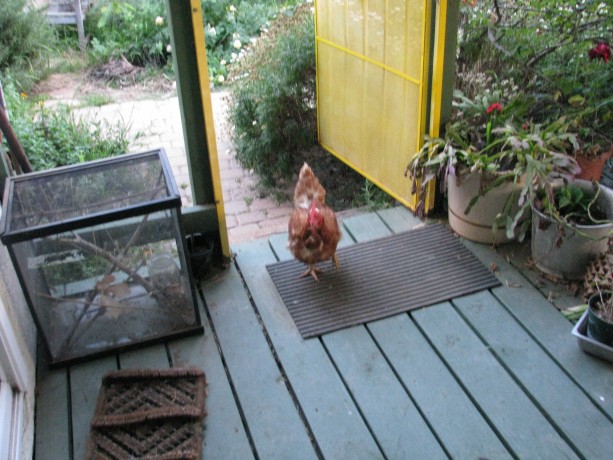
The only animal I have who comes when she’s called. Did I say run? Yes, her leg improved greatly, from a painful hop to a piratey roll. Then I made the mistake of speaking on the phone about her within her hearing. I gave a progress report on how well she was doing, and said that I’d try to reintroduce her to the flock again the next day or so. By the next day, however, Viola suddenly had a very sore leg again. She hobbled painfully around. I couldn’t reintroduce her because the other girls wouldn’t be very nice to her. So I nursed her again. She improved. During the Christmas holidays once more I spoke about reintroducing her, and by the next day she was limping badly again. Guess what? Viola got to stay inside for Christmas.
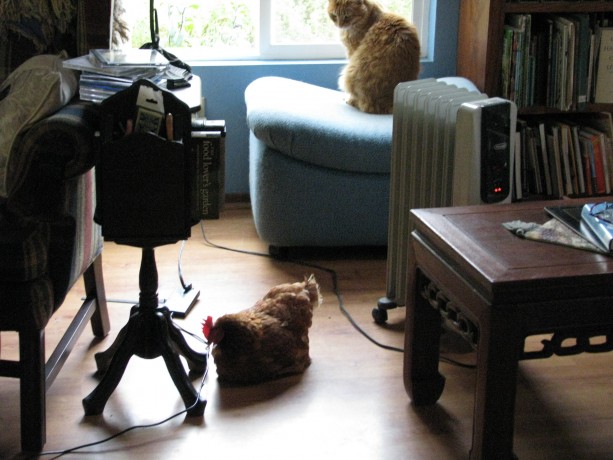
Staying warm by the heater last winter. This healing/reinjury happened yet a third time, and yes I had mentioned bringing her to the coop, so by then I was pretty sure she was either a very good chicken actress, or she was injuring herself to maintain her improved way of life.
The best part of having a chicken in the house I find is at night. While I’m up writing or paying bills and she’s caged, suddenly I’ll hear a sound as if a bomb is falling from a great height just outside the house. It is a high pitched whistle that descends in pitch gradually, but instead of hearing an explosion at the end there is a little soft “brrrup.” The first time I heard it the sliding doors were open and I thought that Camp Pendleton (whose artillery practice shakes the house) had dropped a missle overhead.
When I sneeze or make a loud noise I always hear a comment from the cage. She’ll often croon to herself, too. Viola enjoys music and will sit contentedly both when I’m playing CDs or even when I’m practicing my beginning piano chords on the keyboard. I’m sure she considers herself a songbird because she makes horrible noises of protest when she wants attention.
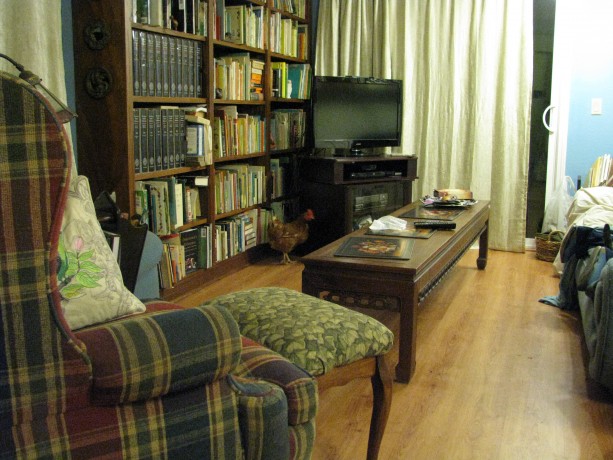
Viola taking a tour of the library. At first I had placed a metal food dish and a flat water dish into her cage. She soon learned that if she stepped on the edge of the metal dish it would clank. She became very good at clanking over and over and over again with her big foot when she wanted out. She’d also manage to spill her water so I’d have to let her out to clean. She’d take the opportunity to run into the other room and check out the cat’s food dishes. Now I just put some feed right on her newspaper, and my daughter cleverly tied open the side door just enough so that Viola can get her head out to drink from a water dish placed outside the cage.

A caged Viola with the waterdish doorway. A friend who knows birds suggested that Viola had bumblefoot, a painful swelling of the pad of her foot. She kindly gave me a week’s worth of antibiotic for Viola in pill form, and I learned a new skill. Or not. By the end of the week Viola and I had developed a whole new relationship which had us eyeing each other warily. There was no change in her condition other than she wouldn’t let me anywhere near her beak without a tussle. Yet again she’s walking very well.
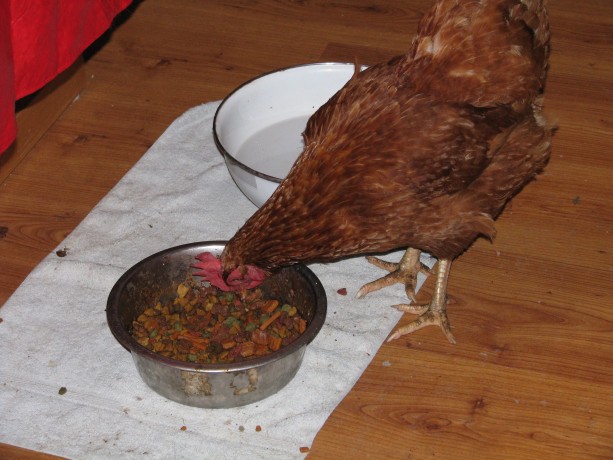
Dog food is high in protein, and fun to steal. I’m not the only one with a house chicken. Social media is a wonderful method of exposing slightly affected people. There are photos of perfectly respectable people – grandparents even – Skyping with a chicken on their laps. There are even businesses who sell products for chickens such as chicken diapers. Yep. Chickendiaper.com, in fact. I didn’t enjoy the diapering part of raising my children so much that I want to reenact it with a chicken, thank you.
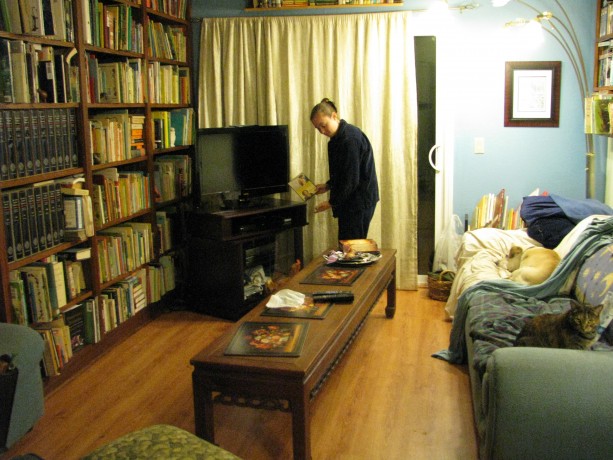
Viola giving her opinion on what video to watch. So here it is the middle of Spring, and Viola’s leg is doing wonderfully. She barely limps. Perhaps I can reintroduce her to the flock at the same time I introduce the chicks. I’m writing this while Viola is rustling about in her covered cage, facing the back of my laptop and unable to read what I’m writing. I just wonder if tomorrow she’ll be limping badly again.
- Animals, Chickens, Permaculture and Edible Forest Gardening Adventures, Pets, Quail, Seeds, Vegetables
Updates on Crate Potatoes, Nursery Plants and Chicks
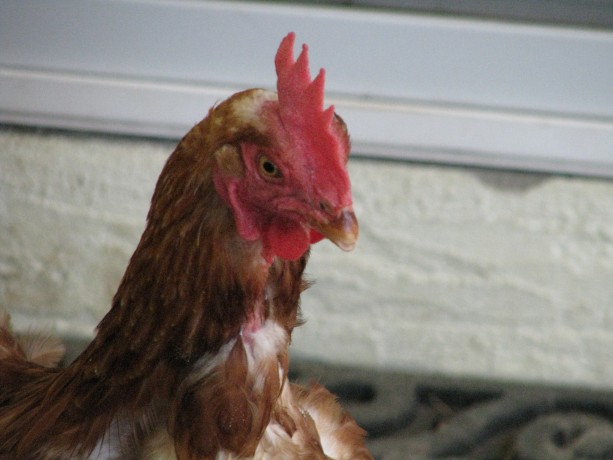
“Whaaa…???” Spring has brought its fervor of growth, of veggies, babies and weeds. Between my bouts of sneezing from pollen (great thing for a gardener to have!), and while the day is very warm outside, I thought I’d update you on how things are going.
A couple of weeks ago I posted about growing potatoes in milk crates. Success so far. The potatoes are growing quickly and coming through the second layer of crates.
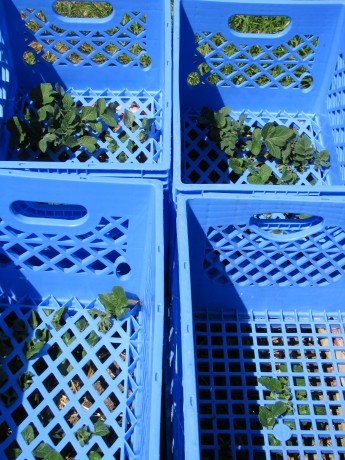
Potato greens emerging through the second layer of crates. I need to backfill with more compost. The potatoes planted in the raised beds have been hilled up as much as the sides will allow. If I am ambitious, I may find some long pieces of cardboard to raise the sides higher, and fill some more.
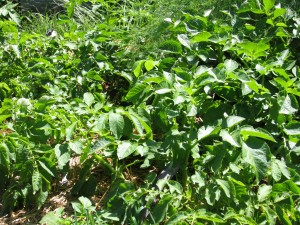
More potatoes! Potato greed!
My nursery bed is mostly ready for transplant out into the larger garden.
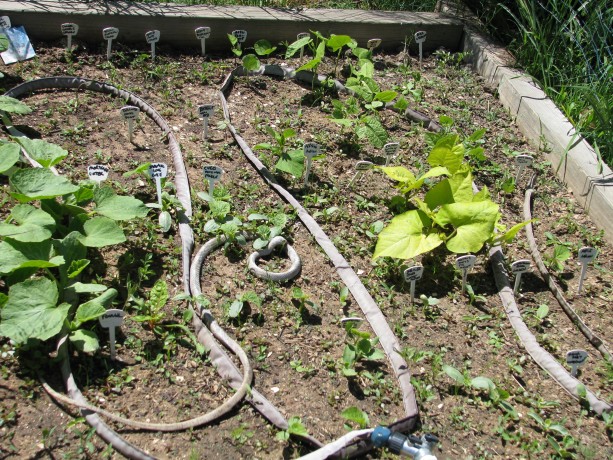
Yes, the rubber snake keeps the birds away. I need more berry baskets to help keep them safe, and I need to build support systems right away for tomatoes and other crops I want to keep off the ground.
The chicks are about a month old. They’ve been living in the downstairs bathtub with heat lamps. There are only seven chicks now. We purchased the eleven on a Wednesday afternoon. By the next evening four were ill. All four died during the night, even after my daughter and I kept them warm and full of antibiotic/vitamin water. We don’t know what happened to them, but at least it wasn’t something that took the whole flock. There are always casualties with day-old chicks. They are shipped in the mail straight out of the egg, with a variety of temperatures, food and terrors. When purchasing a large amount of chicks straight from the hatchery, you’ll often receive extra chicks to ‘make up’ for those that perish. Our chicks that died were both light Brahmas, Annabelle Lee and Daisy, Ruby, one of the Rhode Island Reds, and Hermionie, one of the Americaunas. The rest are growing just fine, although I noticed today that Belle, the remaining Americauna had come to some injury within the last week.
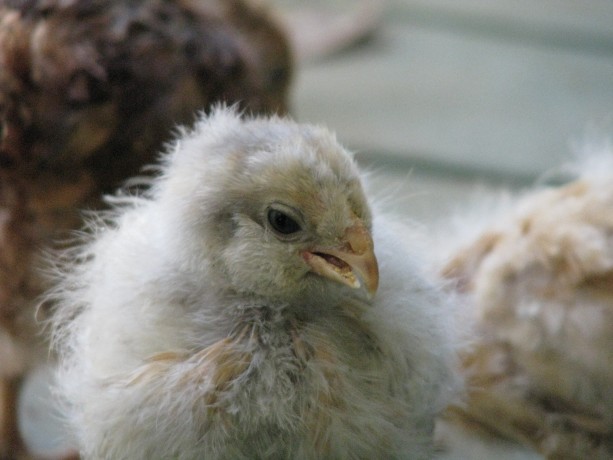
“I’m Belle, the Americauna, and I’m beautiful even with a dislocated jaw.” Her lower beak is crooked and jutted forward, doubtless an injury caused by flinging herself around in the bathtub with the rest of the girls. She is eating well and seems to be aggressive, and there wasn’t anything I could do to the beak with my fingers through massage or gentle manipulation, so I think she’ll have to see it through. UPDATE: my daughter says that she might have ‘crossbill’, which is a genetic condition that gradually shows up. Not much to do about it; some hens thrive and some can’t.
There is always the chance that some of the remaining seven, especially the straight-run cochins, are males, and they will have to find other homes. I’m really hoping for all hens.
Today I not only took the girls out of the bathtub for the first time on a field trip to the warm and safe back porch, but also introduced them to Viola the House Chicken.
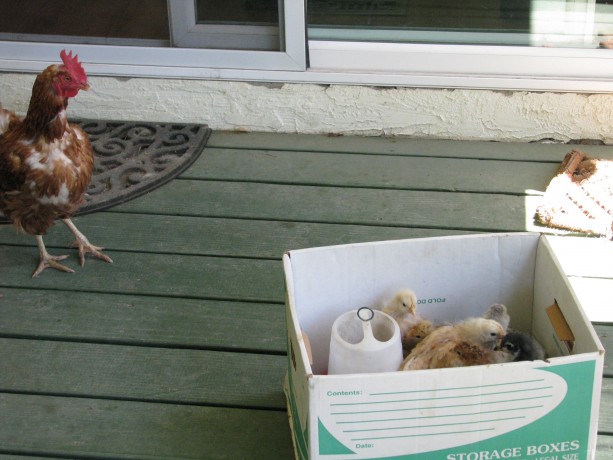
“What the heck are those?” Viola stays in the front yard all day alone, and then comes into the house to her cage at night. She’ll lay in the dog house on the porch where Homer, our lost desert tortoise used to sleep. The chicks are flighty, both in personality and in how they are trying to exercise their wings by sudden wild bursts of flapping that take them off their feet: a surprise to all including themselves. They discovered sunshine, leaf bits, perching,
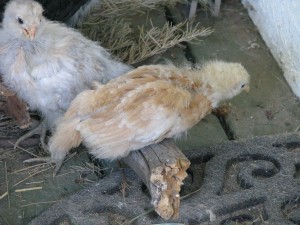
I can perch! and that Viola was absolutely afraid of them. Viola did all she could to get back into the house through the screen while complaining horribly.
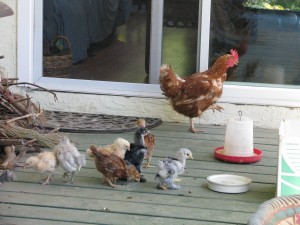
“Get me away! I’m going through the screen if I have to!” I realized that she needed to lay and the chicks were blocking her entrance to the doghouse. I let her in and barricaded the pathway and she settled in whirring grumpily to herself.
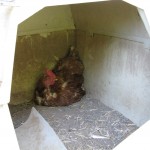
“Can’t you see I’m doing serious stuff here?” Just now I heard her complaining at the top of her lungs to find that the chicks had visited her, and one bold one in particular, aptly named Bodacea, was standing next to her either inquisitively or in horror. I seperated them and they all calmed down.

“I’m Mulan, a black chochin, and I have feet feathers and a cute butt.” 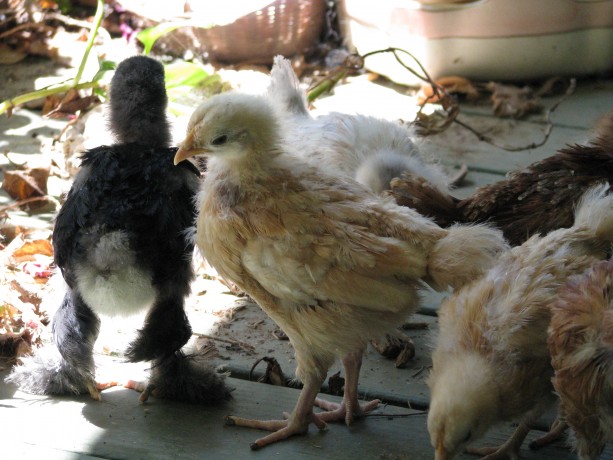
“I’m either Esther or Myrtle, a buff orpington, and she does have a cute butt.” 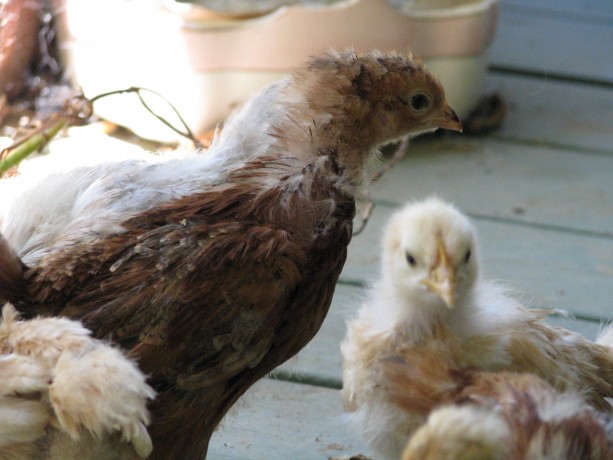
“I’m Charlotte the Rhode Island Red, and I’m going to be just like Viola some day. Without the limp.” 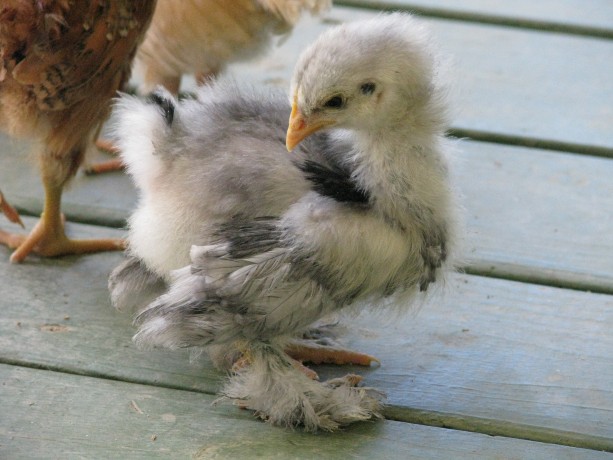
“I’m Bodacea, a blue cochin, and I have a cuter butt.” 
“I’m Malaika, and a Turken isn’t a cross between a turkey and a chicken! We were bred in Transylvania. Go figure.” 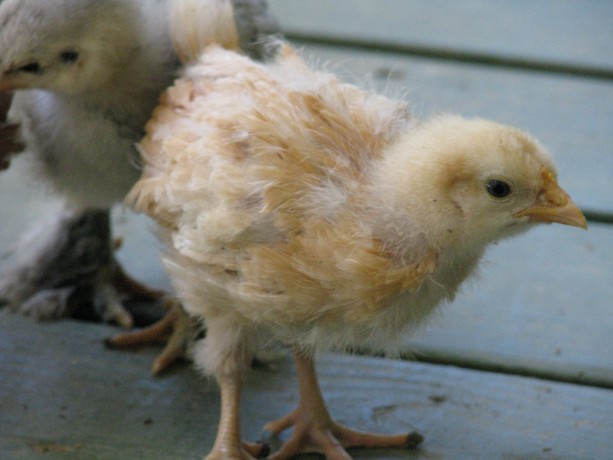
“I’m either Esther or Myrtle, the other buff orpington. The cuter one, obviously.” The nights are still cool and I still have a rat problem in the Fowl Fortress (I’ve been installing a couple of my cats in there overnight to help discourage the looting) so I’m waiting until maybe next week to introduce the girls to the rest of the flock. I’ll oust the Saki the male quail and let the girls take over his house. Its all so complicated!
- Animals, Bees, Chickens, Gardening adventures, Other Insects, Permaculture and Edible Forest Gardening Adventures, Quail, Seeds, Soil, Vegetables
Protecting the Little Guys… and a little about diatomaceous earth
When transplanting little plants out into the big garden it feels like sending your child off to their first day at Kindergarten. All kinds of things can happen to them in the big world. For children… that’s too large a topic for me (Kindergarten mother survivor here). For plants I can give you some advice.
Besides watering too much or too little, and root disturbance while transplanting, little guys can be eaten by bugs, birds or other animals, or simply get lost and overlooked. (Here is a container growing tip: as your seedlings sprout and grow, gently pass your hand across them every time you are with them. It will make for stronger stems.) (And its fun!)(And you can pretend you’re ruffling their hair and say things like, “Hi, Sonny.” Or not.)
A day before transplanting out of a container or from a nursery bed, water the sprouts well. If they’ve been in containers for awhile those roots may be going in circles and the water can’t penetrate from the top very well. If that is the case, put the pots in water for half an hour until moisture is wicked into the pot thoroughly, then allow to drain. I say to do this the day before because if you water just before planting the soil around your root ball will fall apart, breaking fine hair roots and shocking your poor little guy. Some plants hate their roots being touched so much that this would kill them. By the next day after watering the container will still be moist, but the soil should be solid enough to stick together when tipped out.
Dig a hole twice as wide and twice as deep as your plant, then backfill with a mixture of good compost and the soil from the hole. This will help acclimate the roots to the soil change. Water the hole, and if you’re really industrious water with compost tea. Set your plant into the hole and firmly press the soil around the plant. If you are planting tomatoes, eggplant or peppers (all in the same family) you can set the plant more deeply into the hole; they will form more roots from the stems and become sturdier. The rule of thumb otherwise is to plant so that the soil level of the hole is the same as that of the transplant; many plants will rot if soil is up against their stem. If it is too low, the roots will be exposed and dry out. Potatoes can be trenches and hilled up as they grow, or maybe you will try trashcan or crate potatoes. If you live in an arid area, plant in shallows so that rain can accumulate around the plant. If you live in a wet area, plant on hills so water can drain off. Or if you’re practicing permaculture, plant on the swales!
So your little guy is in the ground and gently tamped in. To keep off the birds and bunnies and mice and rats and whatever else is looking for dinner, I use plastic berry cartons turned over and set in place with sticks or with rocks on top. Reuse and repurpose! They are also good for protecting figs . The cartons allow enough sun in, and also makes it very obvious where the seedling is so that you don’t step on it, or weed the little tomatoes out with the almost identical ragweed sprouts. For larger plants, turn over a milk crate.
I have no native quail in my yard. Due to nearby houseing developments, there aren’t many quail around me anymore. Quail would fill the niche of beetle and sowbug eaters. My hens want only worms, spoiled things, and their big feet do a lot of damage if not watched.
Sowbugs cluster under mulch and do damage to stems and fruit.
I use a little food-grade diatomaceous earth around the seedlings, new sprouts in the garden, around the strawberry plants, and also around plants such as artichoke, corn and chard where ants have begun to farm aphids.
I use it around the trunks of my stonefruit trees to stop the ants, and have been told that it works well around the legs of beehives in lieu of or in combination with cups of oil to keep out the ants. Diatomaceous earth is the finely ground bodies of ancient sea creatures (diatoms). The powder on a microscopic level is full of sharp edges.
When a sectioned insect such as an ant, flea or sowbug crawls on it, it rasps their tender areas and dessicates them. Not something I really am happy about doing to the bugs. I’m only using it on a very small scale. Remember that any insecticide, even DE, kills many kinds of insects not just the targets. You don’t want to eradicate your insects; most of them are helping your plants and your soil. DE will melt into the soil when watered, but only reapply if you still see the target bugs. The problem might already be taken care of.
Use food-grade DE, not the kind that is sold in pool supply stores. FGDE is used in graineries to keep weevils and other bugs out of grain and beans, so you’ve been eating it for years without knowing it. It doesn’t hurt us, nor is it bad to breathe (some people wear masks that they can get from https://accumed.com/n95-mask-for-sale-respirator-safety-face-mask-z1.html, just in case). It is a great, natural and inexpensive way to fight fleas without paying big money for poisons to put on your pet. I have it all over my cats’ bedding.
They sell DE sprayers, but they become clogged. The easiest and least expensive applicator (which can be repurposed)? A condiment dispenser. You know, the plastic mustard and ketchup squeeze bottles in diners. I bought a set of two for $2. You can practice a little to dispense a finer dust.
So I plant my little guys, give them a drink, squeeze a little DE around them, give them a berry basket hat until they outgrow it, then take it off to use elsewhere. If there is still a threat to your plants from critters (somebody was eating my eggplant leaves last year! I mean, really…ick!), then turn a wire gopher cage over the top or make a wire cage to fit and use sticks or landscape staples to fasten into the ground.. These, too, you can reuse yearly.
-
I Shouldn’t Be Allowed Out
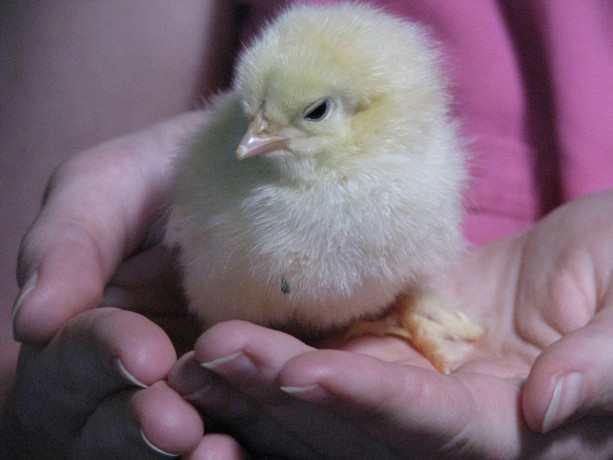
Annabelle Lee, a Light Brahma While returning from a trip with good friends to the San Diego Zoo Safari Park’s butterfly exhibit, my daughter and I stopped at the local feed store to look at the chicks that had just arrived. Big mistake. Please welcome to the world, and to Finch Frolic Gardens, two Light Brahmas named Annabelle Lee and Daisy, two Rhode Island Reds named Ruby and Charlotte, two Buff Orpingtons named Esther and Myrtle, two Americaunas named Hermionie and Belle, a Turken named Malaika, a Blue Cochin named Bodacea and a Black Cochin named Mulan. The names are all literary or historical.
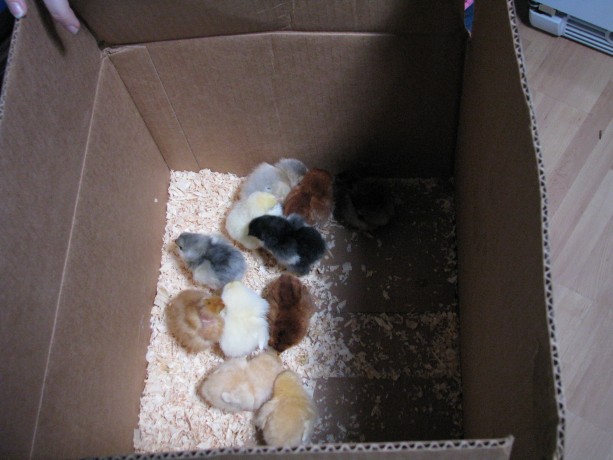
Box of chicks. Eleven? Did I really get eleven?? So, the turkin was all alone since someone had bought all the others earlier in the day except her. Turkins are not crosses between chickens and turkeys, they are a bare-neck breed from Transylvannia. The cochins are ‘straight run’ which means there is a 50/50 chance they are males, which I don’t want, so the owner gave me two with the guarantee that I could return them if they turned out not to be hens.
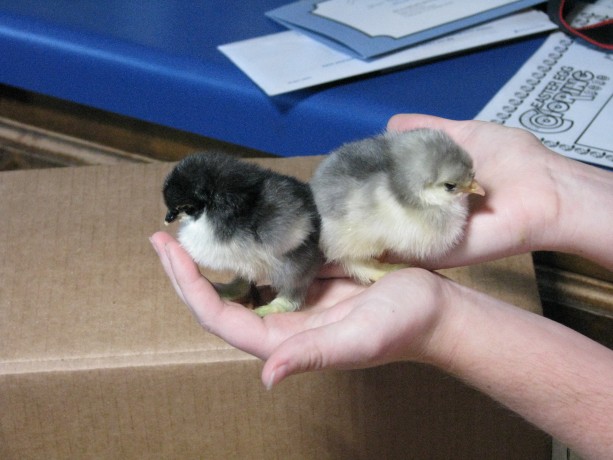
Mulan and Bodacea. Hopefully. They have the cutest feathery feet and rounded butts. The rest of them are probably pullets (females) but there is always a chance that some aren’t. Oh, and they are small and cute and a lot fit into a small box. For the moment.

Belle, Bodacea and Hermionie. Within a few months they will be joining Miss Amelia, Lark, Chickpea and Madge in the Fowl Fortress, and maybe Viola if she is no longer a house chicken.
UPDATE: The chicks were fine Wed. night, but by Thurs. afternoon four were weak and not eating or drinking. After a long evening and night keeping them warm and feeding them antibiotic in Pedialite with vitamins, they all succumbed. Ruby, Daisy, Annabelle Lee and Hermoinie passed on. A week later and the others are thriving. We lost both Light Brahmas, and I’m considering buying two more just because they are so cute. After much research we still have no idea why these four were ill. Day-old chicks go through a lot after hatching, including a rough mail shipment, overcrowding, and change of diet, temperature and light length. Hatcheries will often send extra chicks to make up for the percentage naturally lost due to shock or illness. Now I just hope none of the girls are guys!
- Animals, Chickens, Compost, Gardening adventures, Hugelkultur, Permaculture and Edible Forest Gardening Adventures, Soil, Worms
Strawberry-flavored Hugelkultur, Please
A few months ago my daughter and I thinned out the raised strawberry bed.

Way too many plants. I planted the extra strawberries under the passionvine arch,
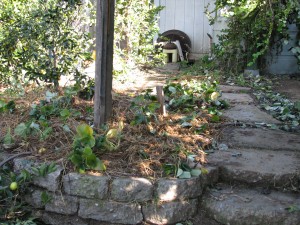
Under the passionvine trellis. using well pooed and pecked and rained-upon straw from the Fowl Fortress as mulch.
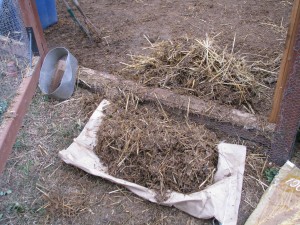
Good yucky straw. However the soil level in the raised bed has become lower, and the Bermuda grass has grown higher. Time for a re-do.
When I’d originally planted the bed a few years ago, I’d heard about burying wood to hold moisture and improve the soil. Some little thing we call… hugelkultur. I laid old lime tree logs along one side. They began to break down and some really cool mushrooms came up.
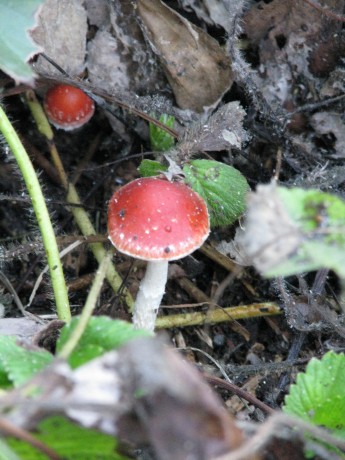
Cool mushrooms. Strawberries sent runners out and they rooted right in the wood. A great success.
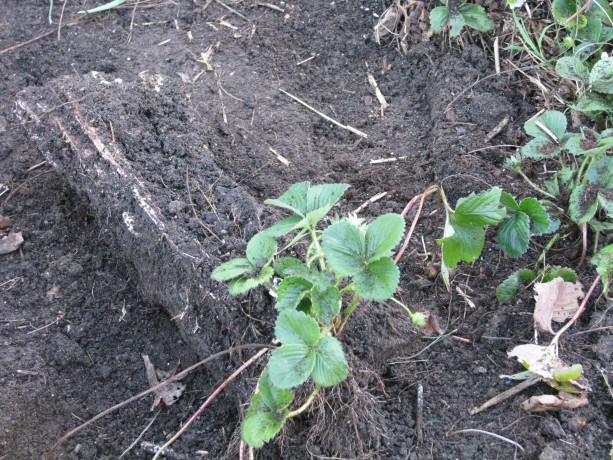
Strawberries rooted right in the wood! Since I don’t have ready compost to fill such a large bed right now, I decided to do the hugel-thing in the entire bed. I spent several hours digging out the strawberries and the Bermuda grass.
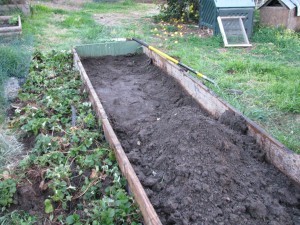
Making the bed: everyone out! Then I pulled the soil back and was simply amazed.
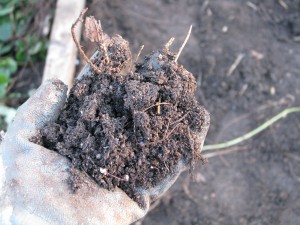
Beautiful soil It was crumbly like prime worm castings. I lined the bottom of the raised bed with the logs on top of the wire I’d laid across the bottom to deter gophers and mice.
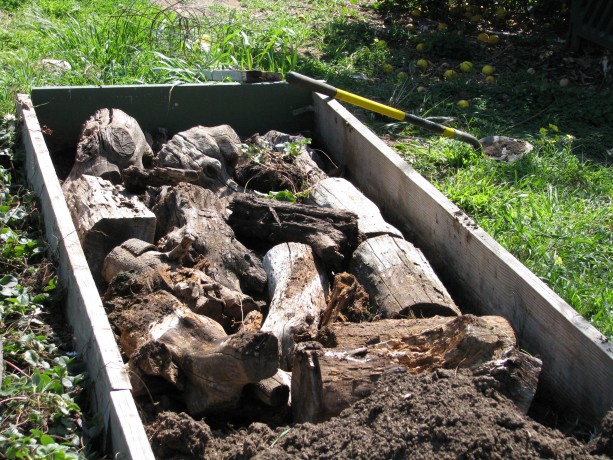
Old lime logs. Then I shoveled heavy clay out of the new bog area and threw that in and around the logs; the wood would decompose and turn the clay to great soil, and the clay already had a lot of interesting microscopic creatures in it from being at the edge of the pond.

Heavy clay. And I do mean heavy. On top of that I sprinkled some pigeon guano I recently received from some wonderful new friends who rescue pigeons. (They are wonderful even if they hadn’t given me the guano. I have many friends who, in fact, are guano-less. Just to clarify.) There were a lot of pigeon peas in the guano, but if they sprout its all good because they are nitrogen fixers and will only help things along. Some sugar was added to help stir up the bacteria in the clay.All along I watered everything in, including hosing down Lark the fat, barren Barred Rock hen who just wouldn’t take no for an answer and kept jumping into the bed to steal the worms!
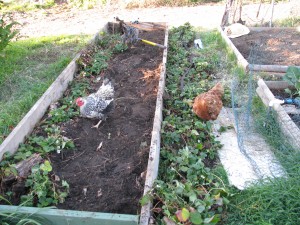
Get away from my worms, hens! My hens are such prima-donnas that they refuse to eat sowbugs and just go for worms. Geez! Lark got back at me later by making me come after her when it was time to shut them in for the night.
The last layer on the bed (and I don’t mean a chicken) was the good soil into which I replanted the strawberries. I did this process in thirds and ended up with a lot of extra strawberries.
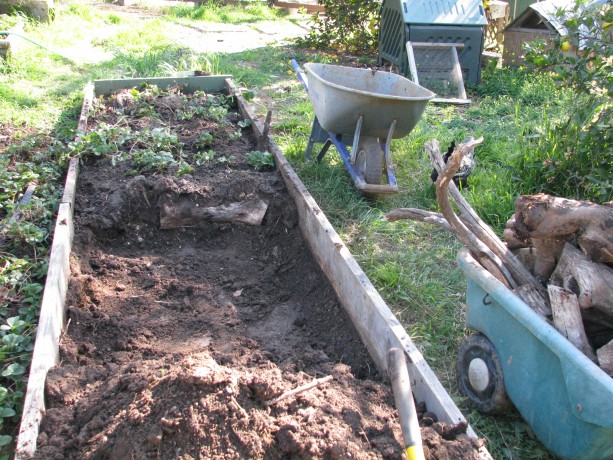
A third section done. As it was nearing sunset and I was becoming chilly in my shorts and sleeveless shirt, I hurriedly planted the extras up under the passionfruit trellis, in with the others from the previous planting. Most of them had happily survived.
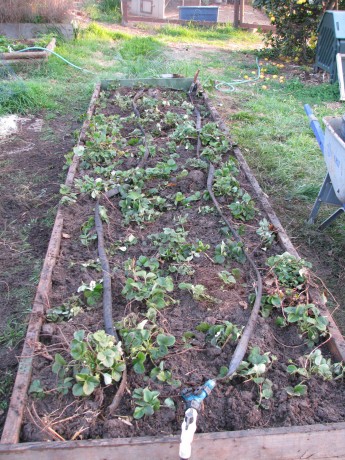
Finished! The leftover soil I sprinkled on top, laid the soaker hose back on top, and voila! A somewhat shocked but hopefully soon-to-be-happier strawberry bed.
There are a couple of wild mallards that come to the pond and have grown trusting of me up to a point. I throw game bird food by the pond for them. I don’t want to tame them, but I like it that they don’t fly off in a fright every time I come near. Its better for their health not to be so stressed. Makes me feel good, too.
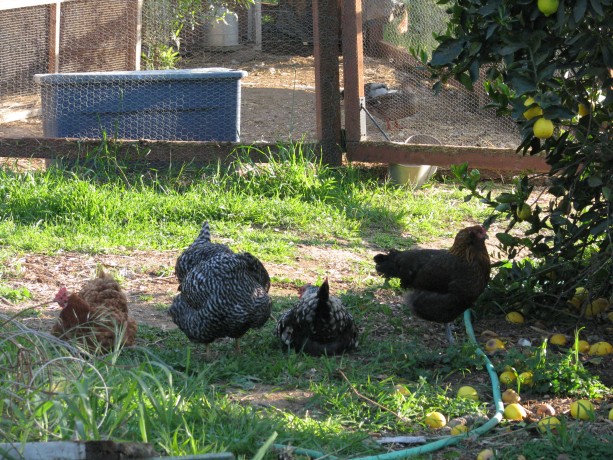
Hen line-up. But what is in the coop behind them? While I was digging I looked up to find my hens all in a row watching me, and beyond them inside the Fowl Fortress (the door of which I’d propped open) were the two mallards! They were perfectly content to be eating what the hens hadn’t eaten, and were even sitting in there enjoying… I don’t know… forbidden territory?
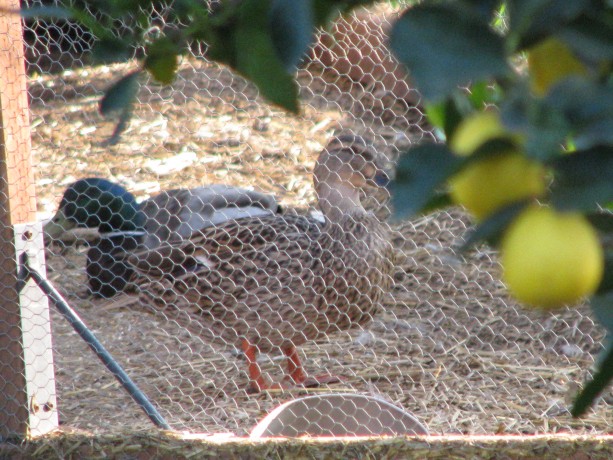
Just make yourself at home! The alluring and romantic smell of chicken poop? After awhile Miss Amelia wandered in there and the mallards wandered out. They’re welcome in there, but if they want me to build them a castle of their own, forget it. They already have the floating duck house, after all!
- Animals, Bees, Birding, Chickens, Gardening adventures, Heirloom Plants, Permaculture and Edible Forest Gardening Adventures, Pets, Photos, Ponds
It Might As Well Be Spring: an Indulgence in Prose
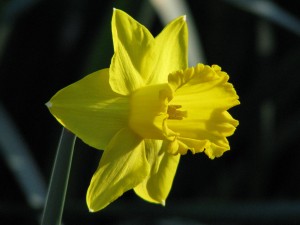
First daffodil, face to the dawn. Mornings find me waking before sunrise, throwing cats off my bed, rousing my elderly dog for her morning ablutions, and scampering down to the hen house in my robe and slippers (and some mornings warm hat and scarf) to feed the hens and the wild ducks, and the tortoise.
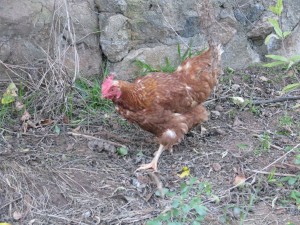
Viola seeing what new seed is available since the night before. Last night when I let Sophie out for her final walk of the night the Santa Ana winds were like a warm caress, riffling through the palm fronds in the dark. Orion sparkled overhead, moving into the position it was in for the birth of both my March babies half a lifetime ago.

Mourning doves in a morning sky. This morning the air was expectant. The garden seemed to emit a trembling energy; an excitement roiling to the surface, but afraid to burst out in full in case of another frost.

Vanilla-scented heliotrope. Indeed another cold front will be moving in with much-needed rainfall later this week. For now, the bold grasses are up and reckless early stonefruit have blossomed out, much to the joy of the hungry bees.
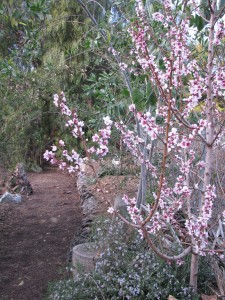
White peach. I could almost hear Browning’s Pippa chanting in my head. But not too much.
The ornamental pear trees all around town are in full glorious bloom. Yesterday while driving from the Community Center to the bookstore there were enough petals strewn in the road as to cause a whirlwind of white as I drove through. An eddy of petals around my car. Joy.
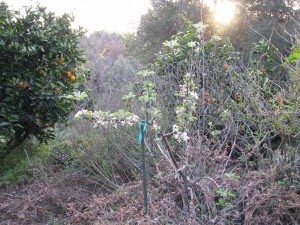
Almond just breaking bud. This weekend is the Great Backyard Bird Count, as well as my two regular bird count days for Project Feederwatch. Before breakfasting I filled seed feeders and enjoyed the show while eating my fresh egg, asparagus, toast and cinnamon tea. Twitterpating is definitely in the air as birds pair up and rival mallards chase each other over the big pond.
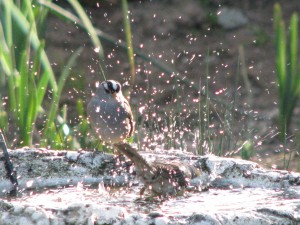
A white crowned sparrow splashing his friend. A Northern mockingbird sips from the bird bath dripper sizing up his territory and listening for new sounds to add to his repertoire. A buzzy rufous hummingbird guards the nectar feeder from the larger and flashier Anna’s. A long-mated pair of crows hang out preening each other on the telephone wire.
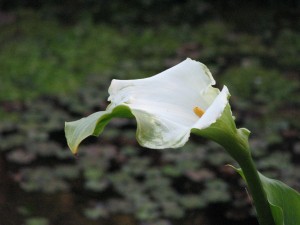
A green-white pond calla. Frogs are croaking amorously in the damp rushes. To my complete joy, far earlier than the bulbs strewn across the property which are just peeking green out of the earth, just outside my window are early daffodils and sweet violets, two of my favorite flowers.
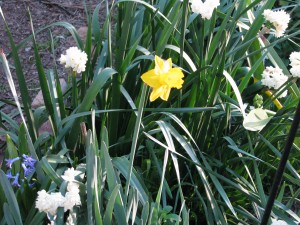
Daffodils, Earlicheer narcissus and a little blue squill. It is still February, and I’m not that great a fan of such a beastly month as February , but for today the paperwork will lie ignored, the cold weather clothes will stay in the laundry basket, and after I take my cat to the vet I will spend the day in the garden (although that isn’t so unusual for me, is it?) listening to the Nuttall’s woodpecker try to drum holes into the telephone pole and smell the scent of Gideon’s trumpet flowers.

Sweet violets. I look forward to tomorrow when I’ll be making two new friends, and to casting seed which will add new life to the garden.
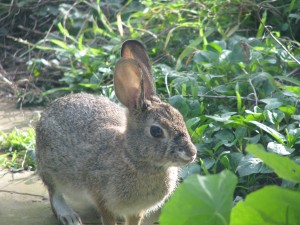
Easter will be early this year. It is all about possibilities, and possibility is definitely in the air today. I will believe Punxsutawney Phil that although it is technically winter, for today it might as well be spring.
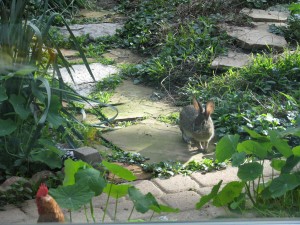
A meeting of the minds. - Animals, Bees, Chickens, Cob, Compost, Composting toilet, Gardening adventures, Health, Heirloom Plants, Herbs, Natives, Permaculture and Edible Forest Gardening Adventures, Ponds, Rain Catching, Recipes, Salads, Soil, Vegan, Vegetables, Vegetarian, Worms
Southern California Permaculture Convergence! Be there!

Southern California Permaculture Convergence If you are interested in any aspect of permaculture, such as organic gardening, herbs, planting native plants, aquaponics, natural ponds, beekeeping, keeping chickens, and so much more, then you must come to the Southern California Permaculture Convergence. It happens on March 9th and 10th at the Sky Mountain Institute in Escondido. The keynote speaker will be Paul Wheaton, lecturer and permaculturalist extraordinaire of www.permies.com fame. Oh, and I’ll be one of the many speakers as well (cough cough). The Early Bird special of only $50 for both days ends at the end of January, and then the price will rise, so buy your tickets now!
Also, for a full-on demonstration of taking bare land and creating a permaculture garden, there will be a three-day intensive class taught by Paul Wheaton on site the three days prior to the Convergence.
You can read about the convergence here at the official website, which will give you the link perm.eventbrite.com where you may purchase tickets. Also visit the SD Permaculture Meetup page to see all the free workshops that happen monthly all over San Diego.
This convergence is such a deal, you really shouldn’t miss it! And such a bargain, too. One of the best things I find that come out of these convergences is the exchange of ideas and networking among the attendees, and all the practical information you can take home and use right away. One of the largest parts of permaculture is building community, which means sharing with and assisting others.
Really. Don’t miss this! Tell your friends!

